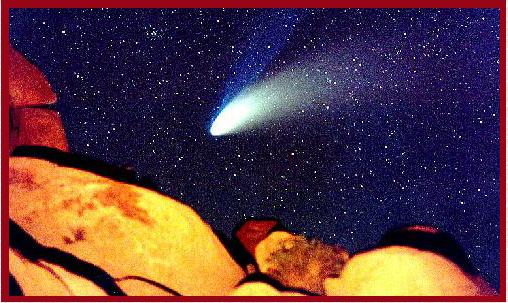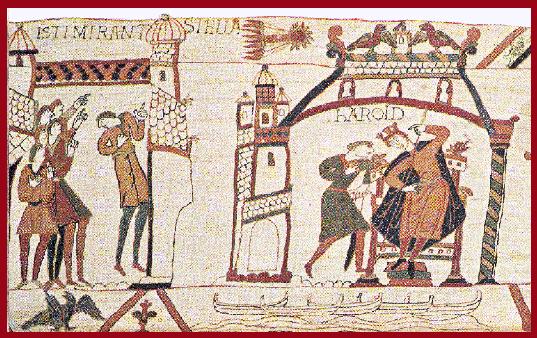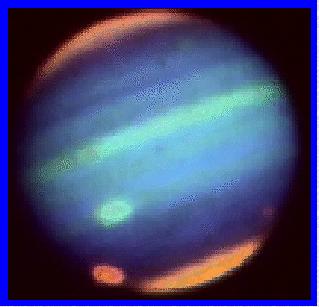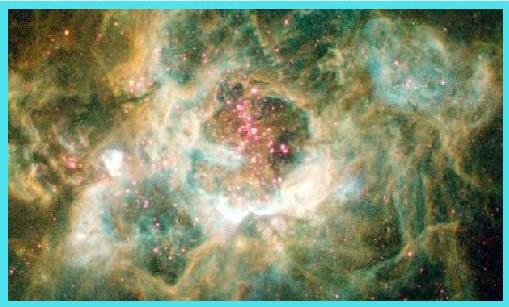 Lesson 1:
Lesson 1:
 Ecology of the System
Ecology of the System
|
 1.7
1.7
 Origin of the Solar System: Clues from Comets
Origin of the Solar System: Clues from Comets

|

Figure 1.7.1 Comet Hale-Bopp The white dust
tail trails behind the comet, while the blue ion
tail traces the outward direction of the solar wind. |
|
Another repository of memories of the early stages of the solar system
are the comets. In essence, these are dusty snowballs, the snow being
ice made of methane, ammonia and water. When these snowballs come close
to the Sun, the ice evaporates and releases vapor, which makes a
tail pointing away from the Sun.
Comets of course have been seen for thousands of years. Their nature was
a complete mystery to Aristotle, who thought of them as a kind of
atmospheric phenomenon. Among ordinary folks, comets were simply bad
omens; a kind of celestial finger wagging, telling people down below to
shape up or else.
The Danish astronomer Tycho Brahe (1546-1601) observed a brilliant comet
in 1577, noting that it came in from the region of the outer planets,
passing through the traditional crystalline celestial spheres without
effort. The spheres did not exist! There was nothing but empty space
between the planets. Newton showed that the path of comets followed
his laws and Edmond Halley, using Newtonian arguments, showed that at
least one comet was on a regular schedule, indicating a highly
elliptical orbit. He predicted, correctly, when it would return.

|

Figure 1.7.2 The appearance of the comet we now
call Halley was recorded in 1054 in the Bayeaux
Tapestry. Halley is a short-period comet returning
to the inner solar system every 76 years.
|
|
Comets, we now know, are errant messengers from one of two populations
of icy bodies surrounding the solar system. One is the Kuiper belt,
which is just beyond Pluto, and may actually include this small and
distant planet as one of its members. The other is the Oort cloud,
a chaotic assemblage of icy debris swirling around the solar
system at some distance, like a cloud of mosquitoes swirling
around people on a summer picnic in Minnesota. In essence,
the short-period predictable comets are from the Kuiper Belt,
the unpredictable one-time visitors from the Oort Cloud.

|

Figure 1.7.3 Impact site of Comet
Shoemaker Levy-9 fragment D on Jupiter. |
|
The icy bodies become comets when a passing large body, even a star
passing at some distance, disturbs their lonely travel in outer space
and deflects their path toward the inner parts of the solar system where
we can see them. More likely than not, they end up as fodder for the
Sun. In rare cases, they hit one of the planets, notably Jupiter. The
spectacular Shoemaker Levy-9 event on July 16-20, 1994 was such an
occasion. Even more rarely, one of these wanderers can impact the Earth.
The Tunguska event on June 30, 1908, apparently was a collision with
an asteroid. On that day there was an explosion heard hundreds of
miles away, near Tunguska in Siberia. On investigating the site, leveled
trees were found in an area more than 30 km in diameter.

|
Figure 1.7.4 Leveled trees at Tunguska in Siberia,
believed to be due to an asteroid impact.
|
The largest impact for which there is direct evidence (a crater and
disturbed environments on a global scale) was the one 65 million years
ago which resulted in the extinction of the dinosaurs and many other
organisms on land and in the ocean. Fortunately, the rate of impacts in
the inner solar system has greatly diminished since the early days. The
Moon's face, riddled by impact craters, is but an ancient memory of this
primeval stage.
Thus, we put together the clues for the origin of the solar system from
the study of ancient objects in this system: meteorites, comets, the
Moon.
But what about the Sun, how can we study its origin?
Mainly, this is done by studying the various stages in the development
of stars in the Galaxy. The first step was to show that the elements in
these stars are much the same as those in the Sun. The next step was to
order the various types of stars seen into evolutionary family trees. It
turns out that small stars develop differently from medium-sized ones
and big ones have their own special course of evolution. Stars of the
size and disposition of the Sun are the most stable and long-lived. But
even they run out of fuel at some point, with awful consequences. But
stars form all the time (we can observe star formation right now, for
example, in the Orion nebula, with a small telescope). So, the death of
some stars engenders the birth of a new generation, as long as there is
plenty of hydrogen around.

|

Figure 1.7.5 Stellar nursery in the Orion Nebula. The
thousand or so newly forming stars emit ultraviolet
radiation that gives this region an eerie glow.
|
|
The Sun, it is thought, will exist as long again as it has existed so
far, and will be reasonably well behaved, so that Life in the solar
system still has a long future ahead.
|





















